After the rest in Dana valley, i.e., in Wadi Dana when I had tea with a local shepherd, I started to return to Dana village. All of this is situated within Dana Biosphere Reserve. I have already said earlier that it is possible for the visitor to go down the trail from the village and the altitude of around 1200 m a.s.l. all the way to the lowland areas west of the mountain range and at the altitude of around 300 m a.s.l., covering the distance of around 16 km, but it is necessary to organise a trip back to the village by car. I was offered that version at the guesthouse I was staying at, but the offer was far too expensive, so I just covered a part of the trail and now I was going uphill back to the village along the same way.
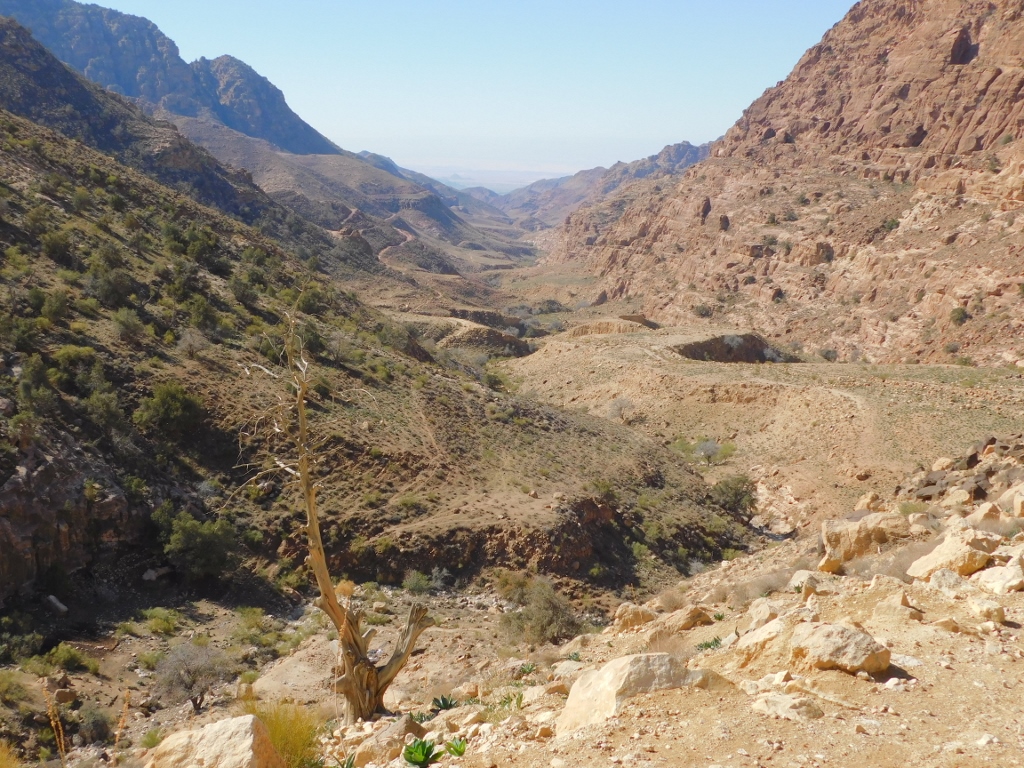 Wadi Dana – you can see the trail leading further to the lowland areas
Wadi Dana – you can see the trail leading further to the lowland areas
After the initial relatively mild slope, much steeper sections appeared. Although it was dry at the place where I took the photo below, while the temperature was relatively pleasant, up, towards the top of the mountain, I could see the snow.
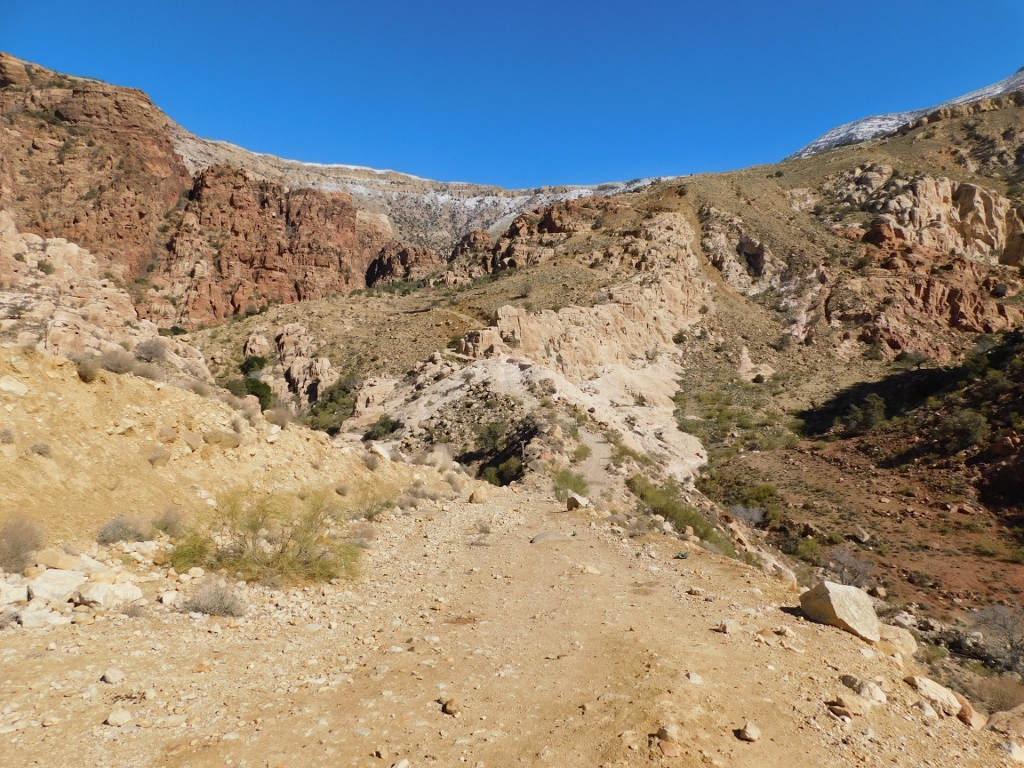 Wadi Dana
Wadi Dana
My goal was the hotel that can be discerned at the very top of the elevation on the right-hand side of the following photo. It was built over the rocks that can be seen there. I did not stay at that hotel, but my plan was to get there.
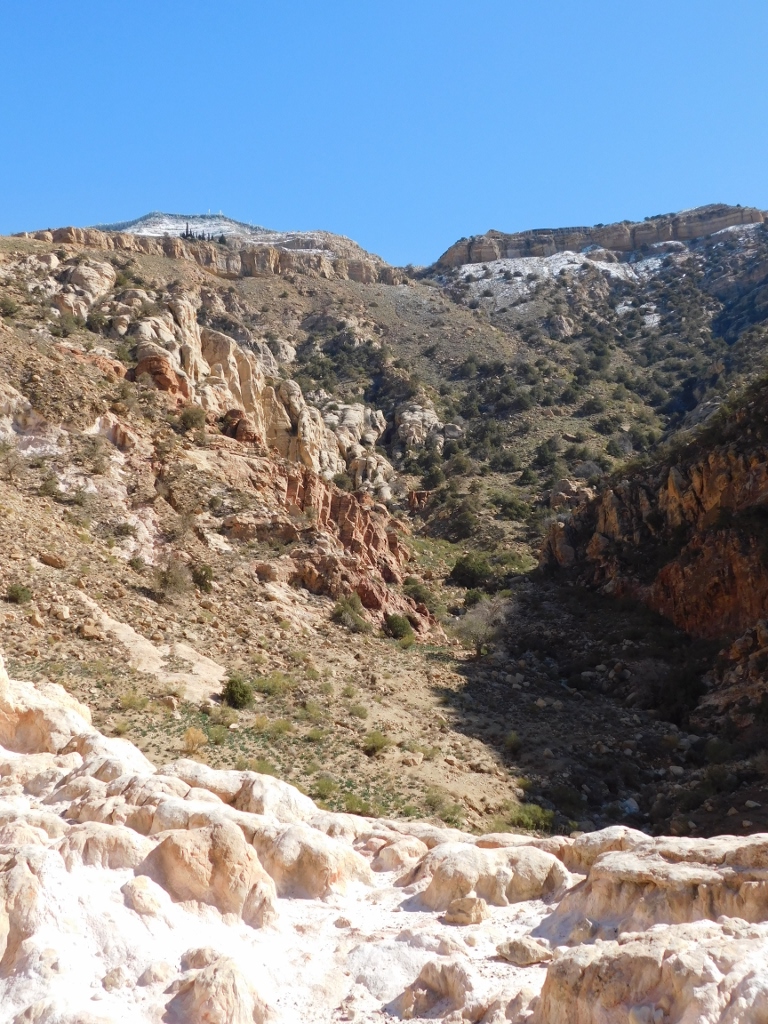 Wadi Dana, Dana village is up, on the top
Wadi Dana, Dana village is up, on the top
Although most of the rocks have some reddish tint, in one section the tops of the rocks are whitish and that creates a very pretty image. Also, the higher segments of the mountain also consist of that whitish rock.
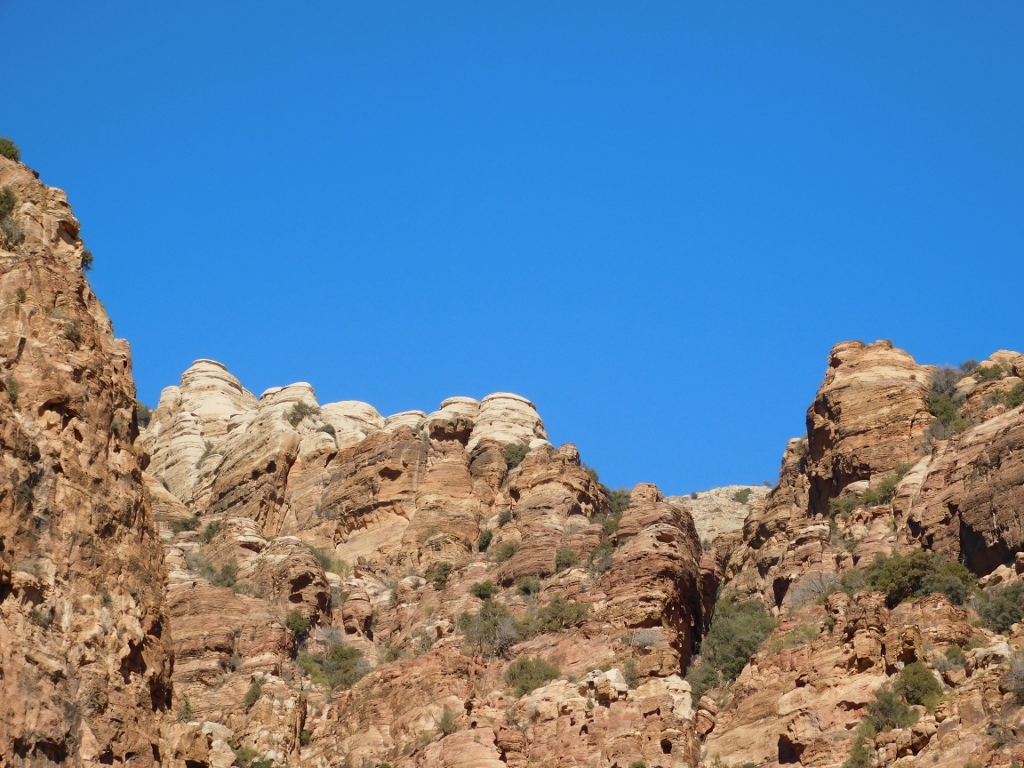 Wadi Dana, details
Wadi Dana, details
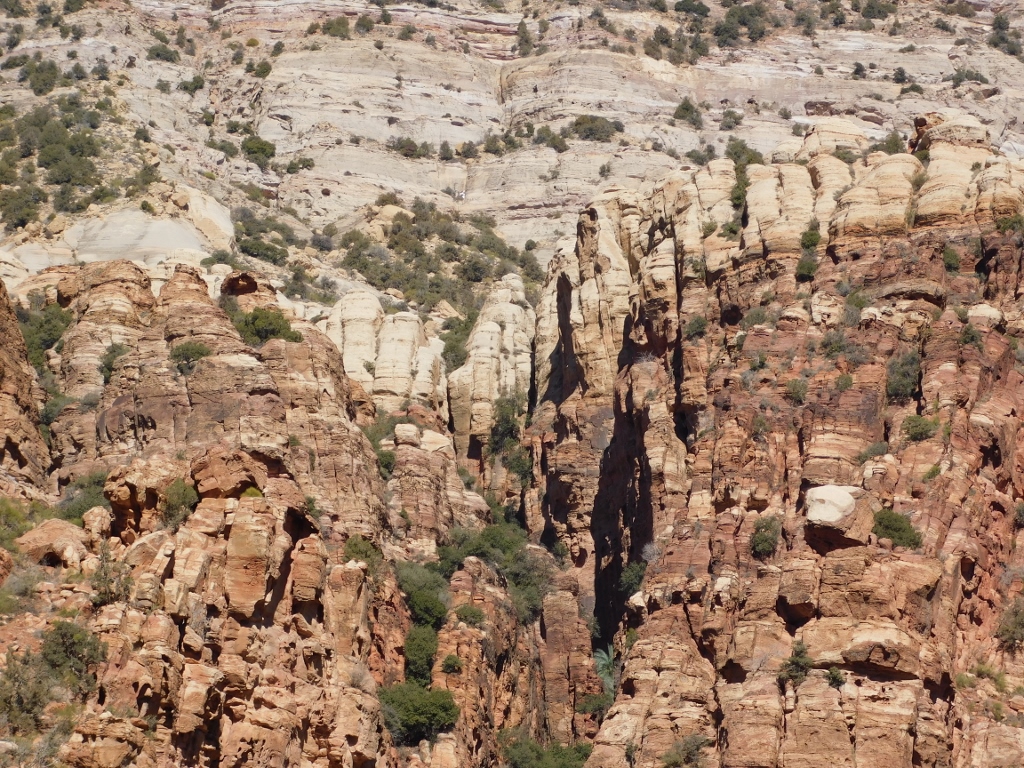 Wadi Dana, details
Wadi Dana, details
But, even the rocks I was passing by had different colours in them and that was truly impressive.
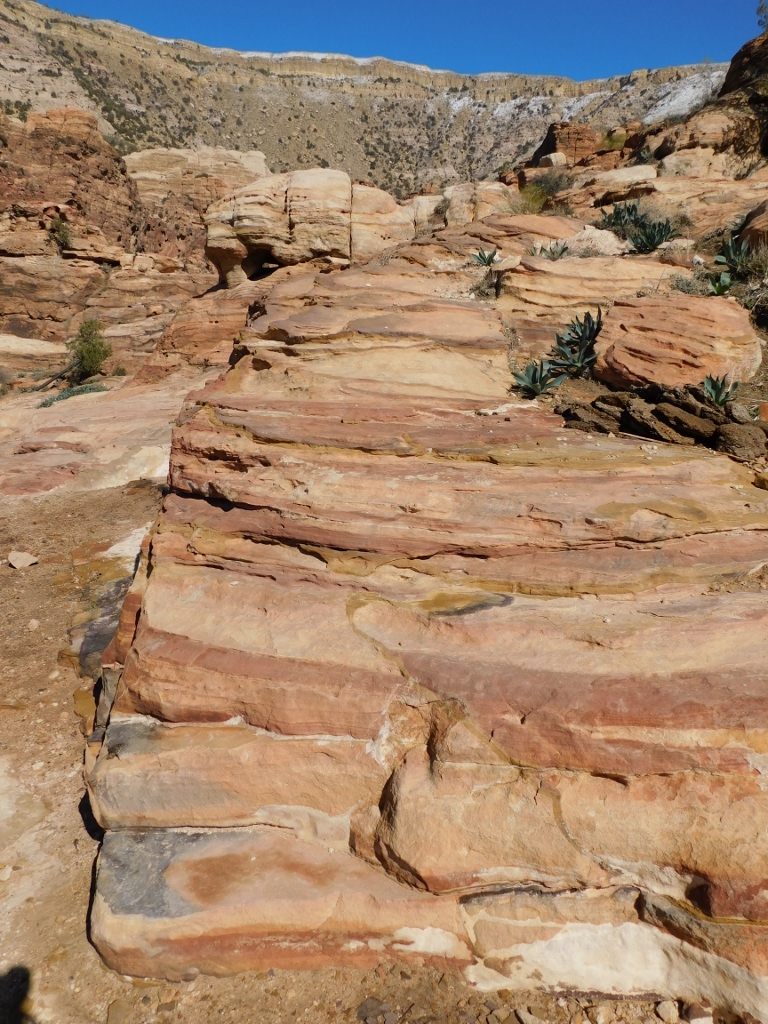 Wadi Dana, details
Wadi Dana, details
Beside one such “multi-coloured” rock, I also noticed some animal dung cakes that were clearly arranged here, maybe in order to dry or maybe in order to pile them up in one single spot. I don’t know what the custom in Jordan is, but I know that in India such cakes are used as heating fuel, because they contain a lot of grass residues. Perhaps the same thing happens here or perhaps they use them as dry manure, which is also a frequent way to utilise these cakes.
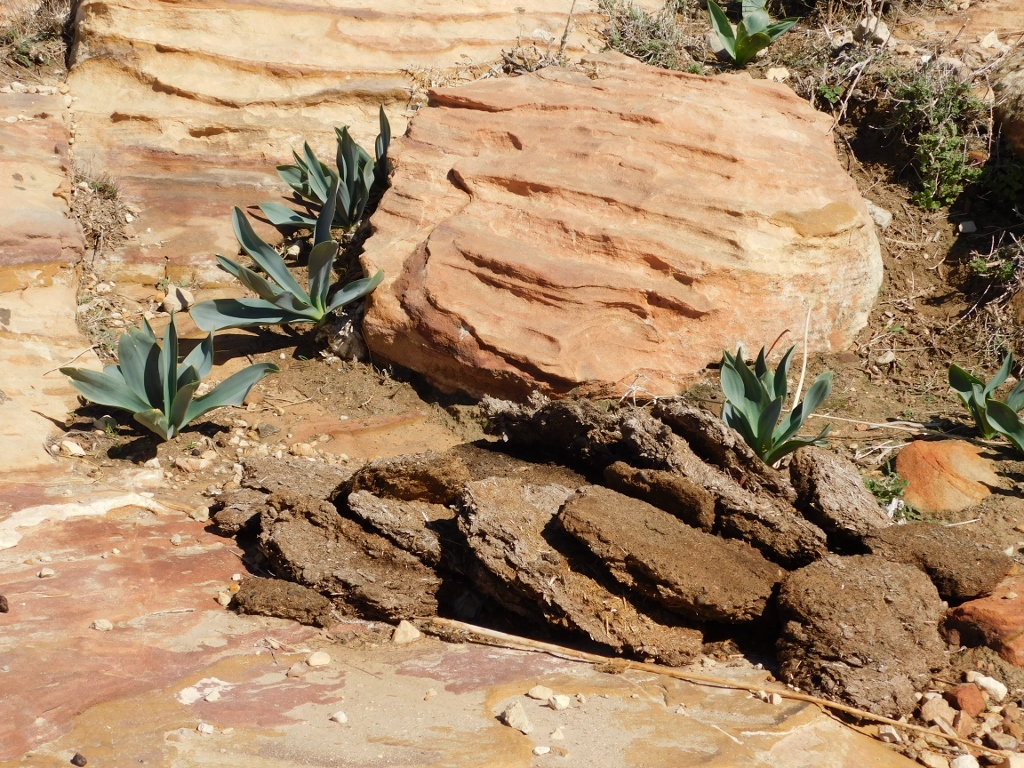 Wadi Dana, a detail with animal dung
Wadi Dana, a detail with animal dung
Along the way, I came across some small birds from time to time, but they mostly didn’t stay in the same place for too long, so I didn’t succeed in taking photos of many of them. On the other hand, plants are great in this respect.
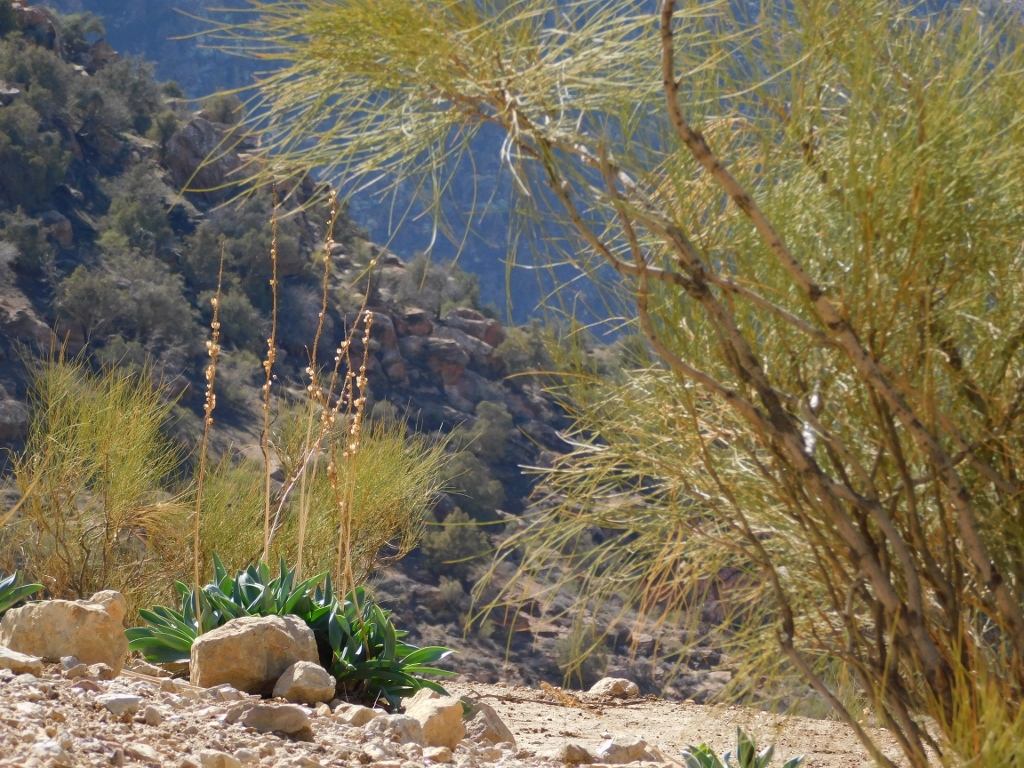 Wadi Dana, a detail with a natural ikebana
Wadi Dana, a detail with a natural ikebana
Although with a lot of breaks and with a lot of effort, I did manage eventually to climb up to Dana village and there, towards the top of the trail I admired again the landscapes that I was surrounded with the whole day.
 Wadi Dana
Wadi Dana
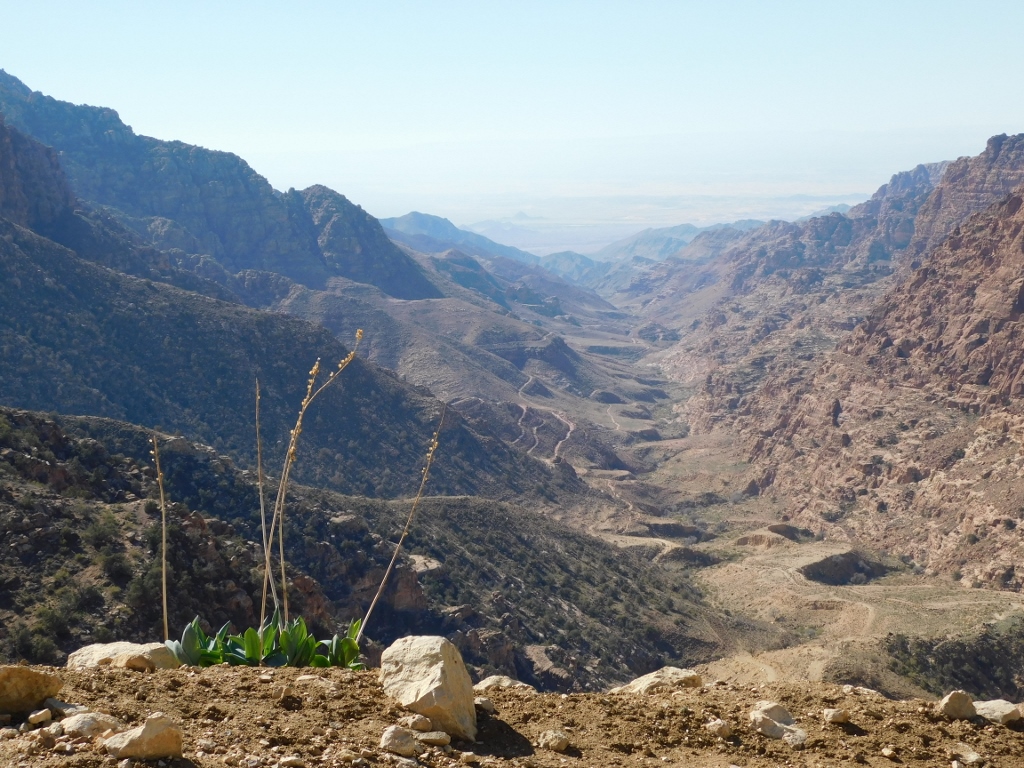 Wadi Dana
Wadi Dana
When all flushed from the efforts I reached a clearing where the trail I walked on joined the main street in the village, I came across a group of young men. They were very joyous, asking me where I was from, welcoming me to Jordan and expressing their desire to have a photo with me taken. Of course I accepted, but I also asked them to take one photo with my mobile.
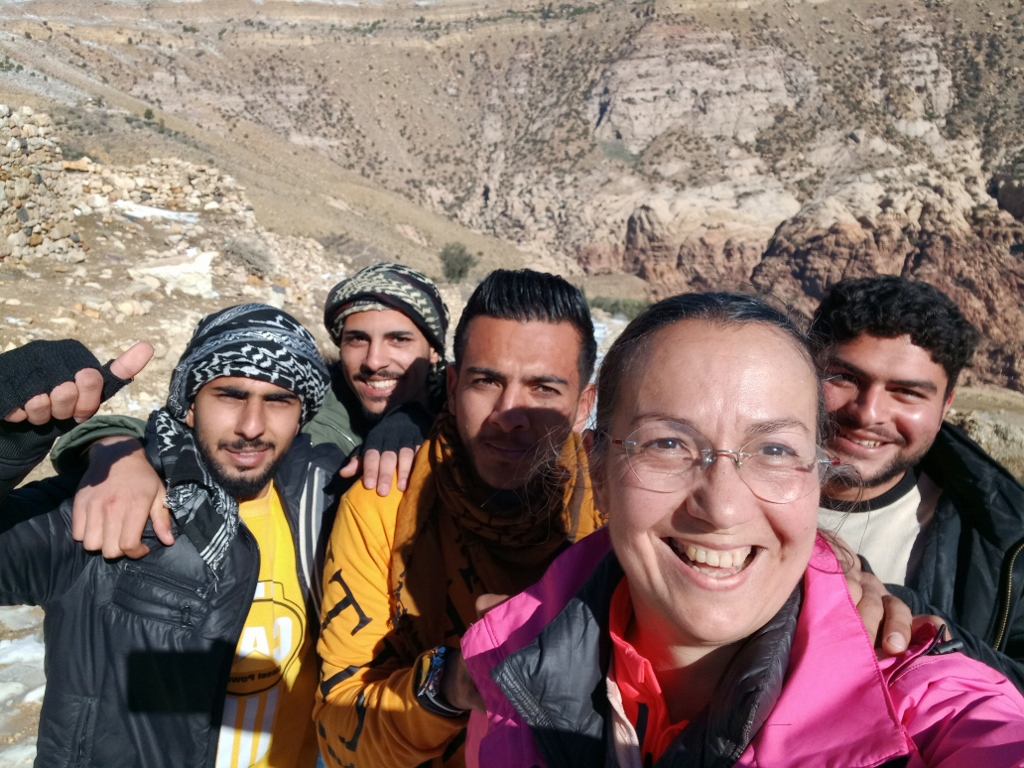 Joyous accidental encounter in Dana village
Joyous accidental encounter in Dana village
Since they kept shouting something during the taking of photos, I said I had to film them with my video-camera. Below is the video that shows what this looked like. I don’t know what they are saying in the first segment, but it is clear that in the second one they say: “I love you Serbia!” Well, that was so sweet on their part and I am truly grateful.
After this merry encounter, I continued walking through the village taking photos of some details, such as one of the side streets covered in snow.
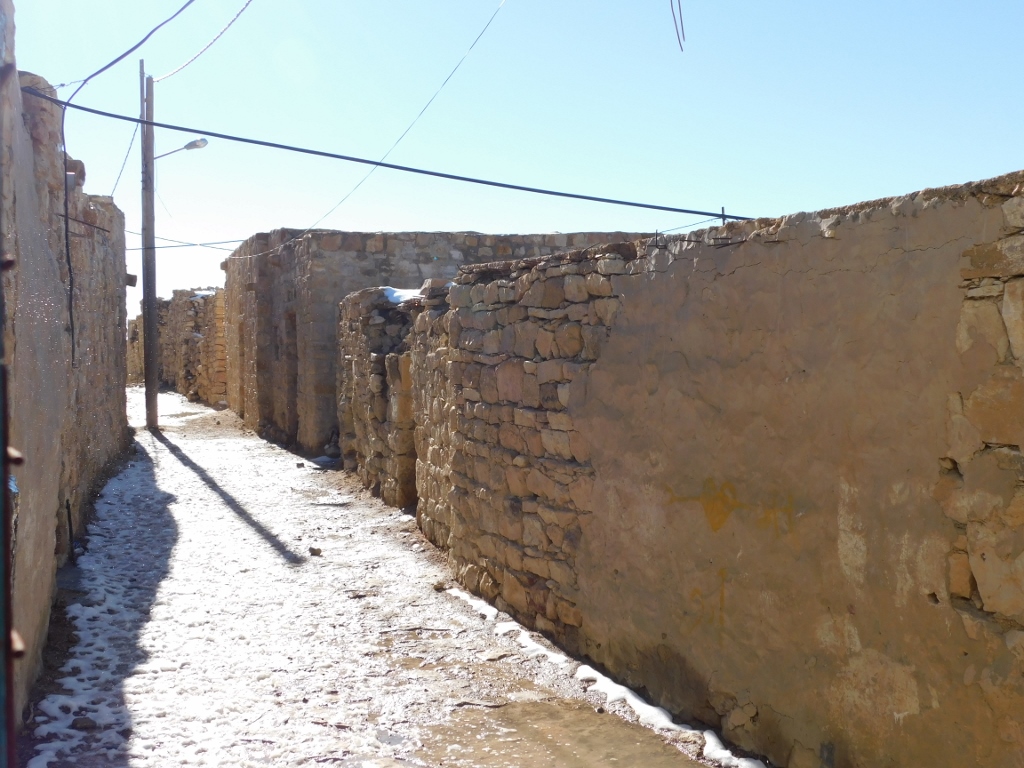 Dana village, a detail
Dana village, a detail
Then I reached a place that was practically a viewpoint and from there it was possible to see a good share of the village built on the very edge of Dana valley (Wadi Dana).
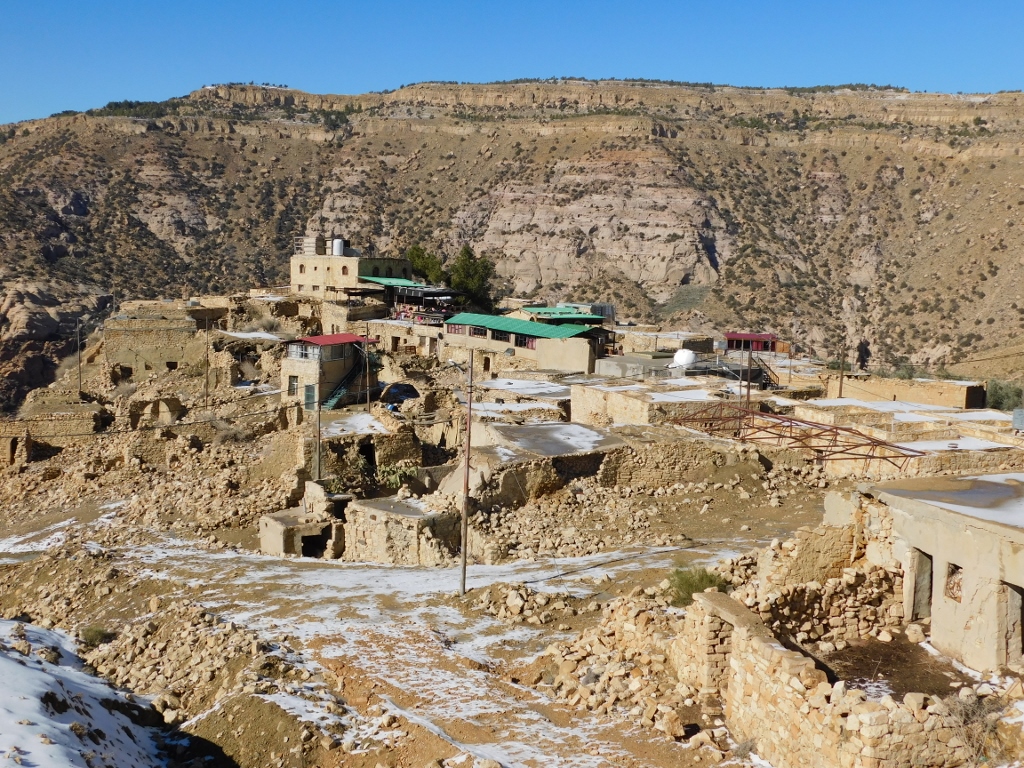 Dana village
Dana village
Nearby I came across a pretty resident. I personally believe that donkeys are underestimated and I find their young especially cute.
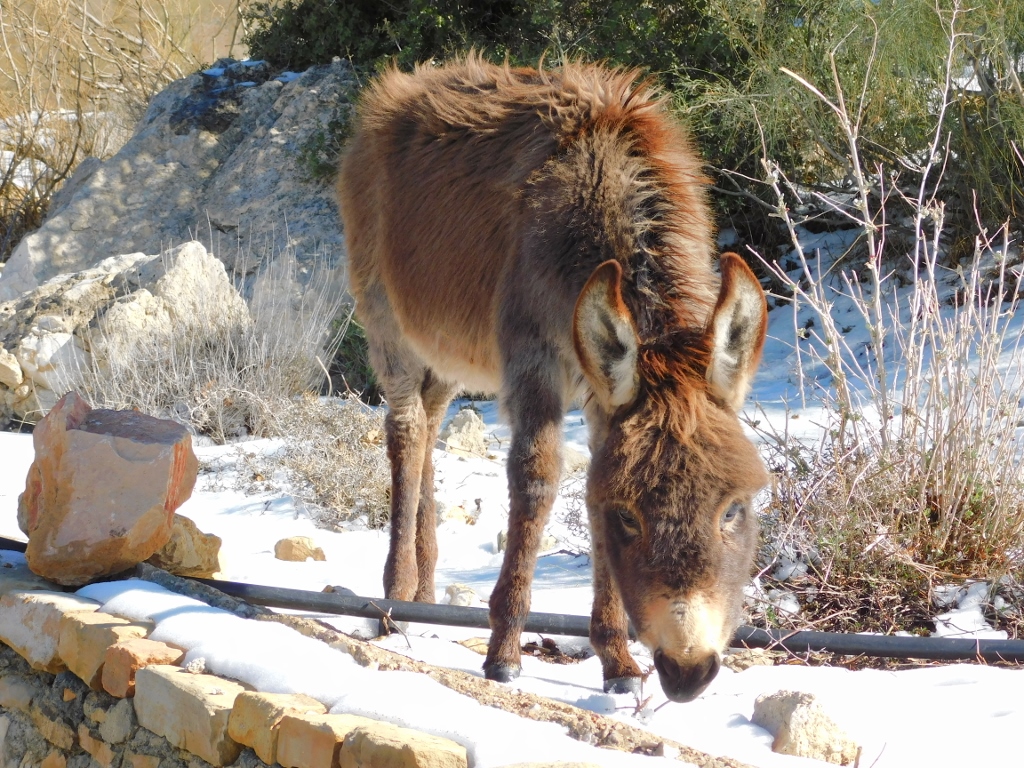 Donkey from Dana village
Donkey from Dana village
As it may be seen from the photos, regardless of the fact that this was all happening in Jordan, it continued to be snowy in several places this January, despite having a sunny day, which only goes to show how low the temperature was.
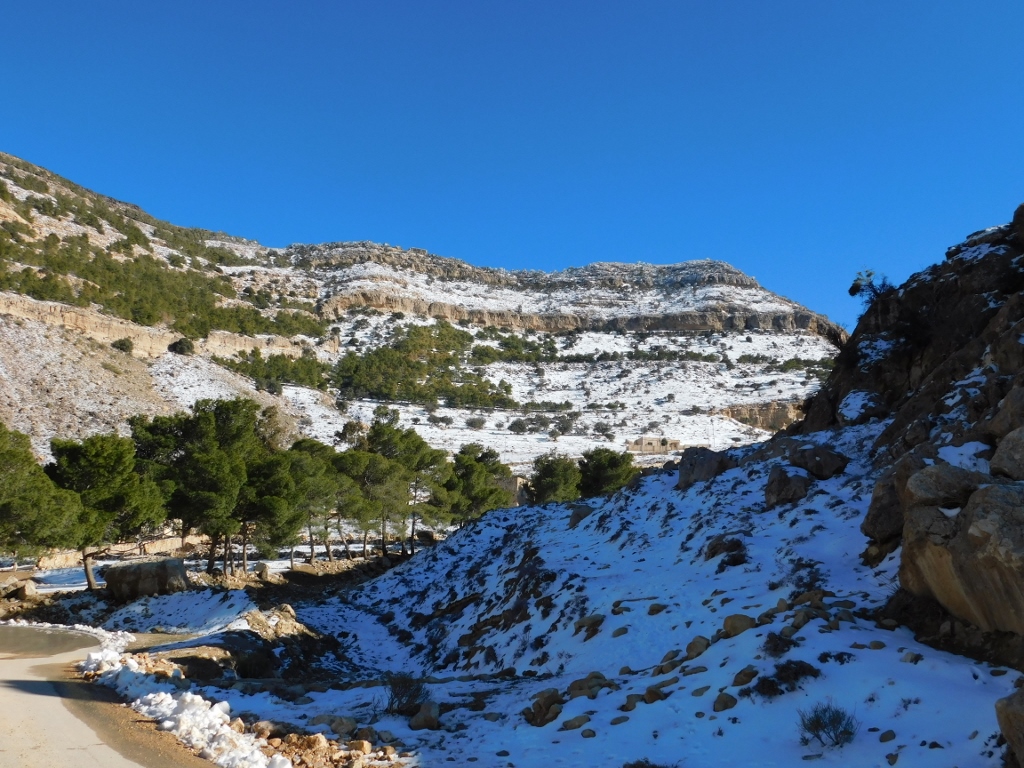 Dana village, surroundings
Dana village, surroundings
I walked to the RSCN guesthouse/hotel where I was the previous day as well and where I was treated to coffee and tea, and also invited to come again. This time around, there was only one guide working there in the reception area, but the two of us had a very nice chat. Namely, I needed some important information and the RSCN guesthouse/hotel was the ideal place to inquire about what I was interested in.
My plan was to go to Mujib Biosphere Reserve towards the end of this journey with intention to walk in nature there. That reserve has several different and absolutely impressive trails, but in January, because of the winter, only one was operational. Even that one closes from time to time, if the weather conditions are not good enough. However, my first problem was how to book a room at the guesthouse managed by the RSCN (The Royal Society for The Conservation of Nature). I tried to do that on the internet, but I got to a point where they asked me to send them my credit card data by mail. This is precisely what every bank says you must not do. I found it very odd, although I communicated with people who got back to me from the official site of this Jordanian society. Of course I had no intention of sending my credit card number or any other data by mail, but I thought it would be best if I inquired in person about all of this precisely at some other guesthouse managed by the RSCN and the closest was this one in Dana village.
That kind guide from the guesthouse/hotel told me that this was indeed their usual practice and that, although it may seem unusual, it functioned quite well and was reliable. Apparently, even if there were any kind of misuse, the RSCN would cover all losses. Hmm!? I was not convinced, but he told me that I should actually make no reservation and just show up there. It was the lowest possible tourist season and just as the guesthouse where the two of us had this conversation was practically empty, in all likelihood that other guesthouse on the shores of the Dead Sea would have a room for me.
We chatted about some other things as well and then I went back to the guesthouse where I was staying. Along the way I took a few more photos around the village that was slowly getting ready for yet another freezing night.
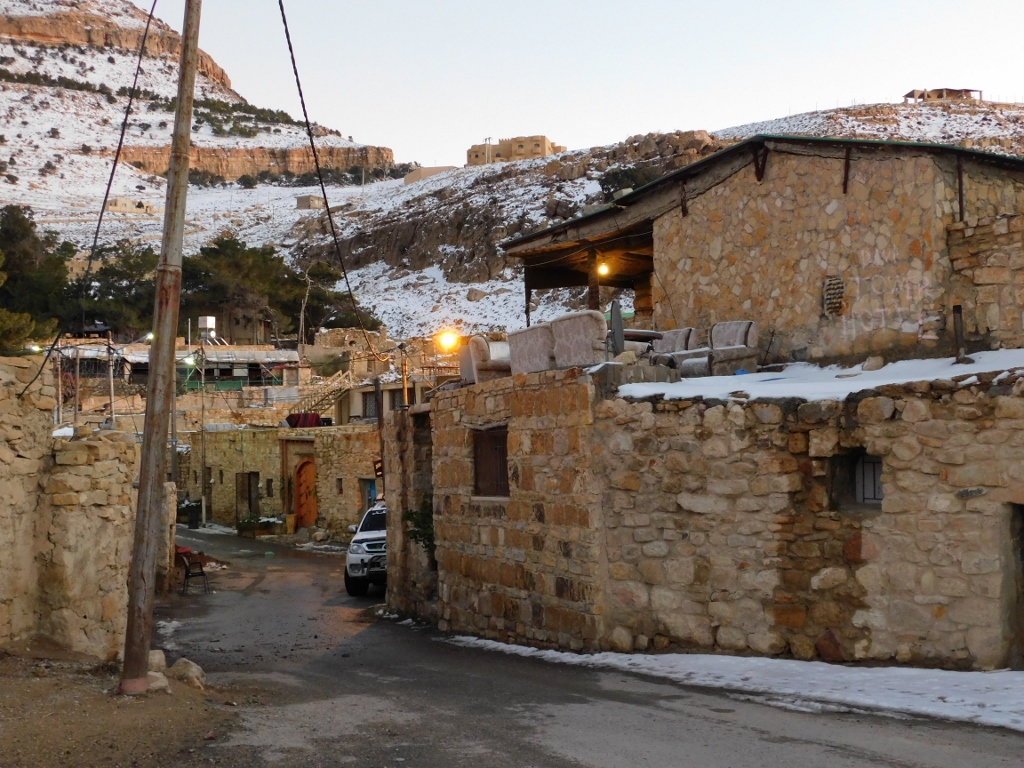 Dana village
Dana village
Bearing in mind my experience from the night before, I added yet another huge and heavy blanket to the combination of covers in the freezing room, which meant that I could almost barely move under that pile of different covers. But, I did make it through the night and the next morning I was ready to continue with my travel through Jordan. Before that, I walked to the viewpoint in order to enjoy once again the stunning beauty of Dana valley, i.e., Wadi Dana, that I had walked through the day before.
 Wadi Dana
Wadi Dana
From Dana I transferred to the city of Wadi Musa by car. Although I kept saying all the time that I prefer public transportation, which is true, that version of moving around Jordan most often did not suit me. Namely, between Dana village and Wadi Musa, there is yet another castle that is recommended as worth the visit and I wanted to see it. In order to go there using public transportation, under ideal circumstances, it would look something like this: hotel transportation to the town of Qadisiyah, bus to Wadi Musa, then taxi to the hotel in order to leave my things, then taxi back to the station, transportation to the town of Shobak (if there was any bus at that time and with supposition that it ran directly), taxi to the castle (because it is outside the town and on another hill in relation to the town), the visit and then back to Wadi Musa using the same combination (taxi-bus-taxi). I avoided all of that by hiring a car with a driver to take me to the hotel in the city of Wadi Musa, but the arrangement was that against some additional money we should also make a stop at Shobak castle where the driver would wait for me while I visited the castle. This did not come cheap, but it was practical. When I added up all individual presumed costs, not to mention the time and the hassle, I did not hesitate even for a second.
On the other hand, the castle itself would ABSOLUTELY not be worth all the bother with the public transportation. It is important for historians, archaeologists, historians of art, etc. Personally, by this time I had started slowly not to care too much about these castles in Jordan, although there is an interesting story about this castle as well.
To start with, I was fascinated by the surroundings of the town of Shobak and the castle of the same name, while the driver made a stop so that I could take a panoramic photo.
 Area around Shobak
Area around Shobak
The castle itself, i.e., its remains and the hill on which it is situated can be practically seen in the previous photograph, too, to the left, but since everything is of almost the same colour, the hill and the stones that the castle was made of, it is difficult to discern, unless you know exactly what you are looking for. That’s why here is a segment of the photo above, but zoomed in.
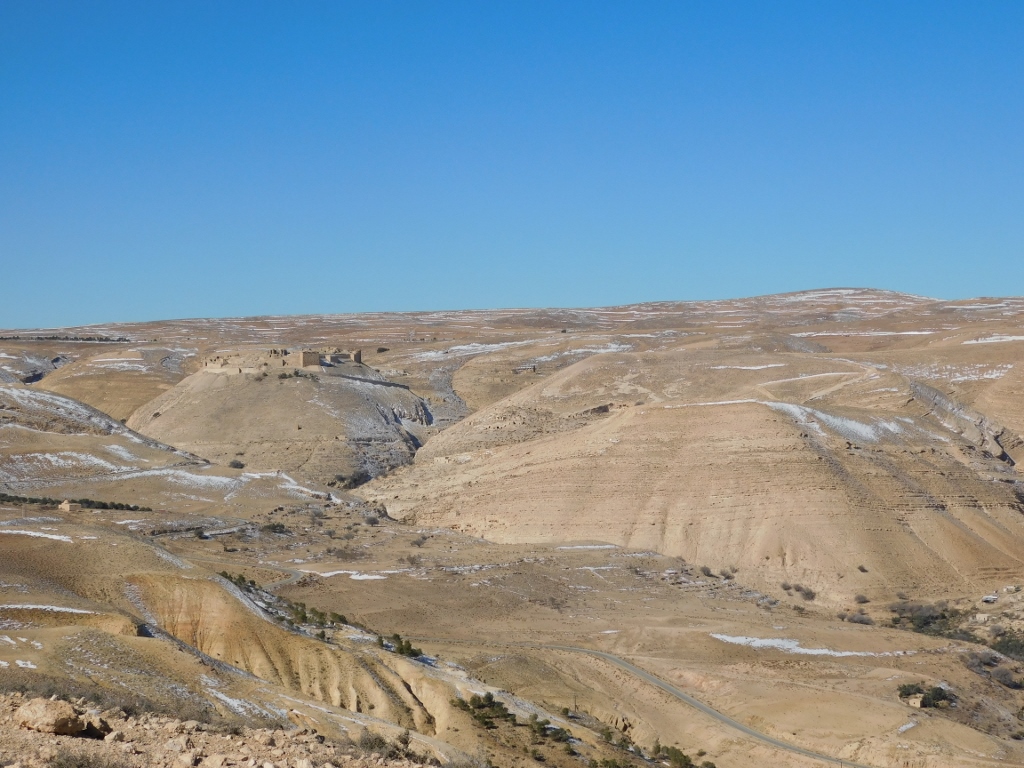 Shobak Castle, on the top of the elevation on the left-hand side of the photo
Shobak Castle, on the top of the elevation on the left-hand side of the photo
And yet, only when I zoomed in even more, it was possible to see the castle well.
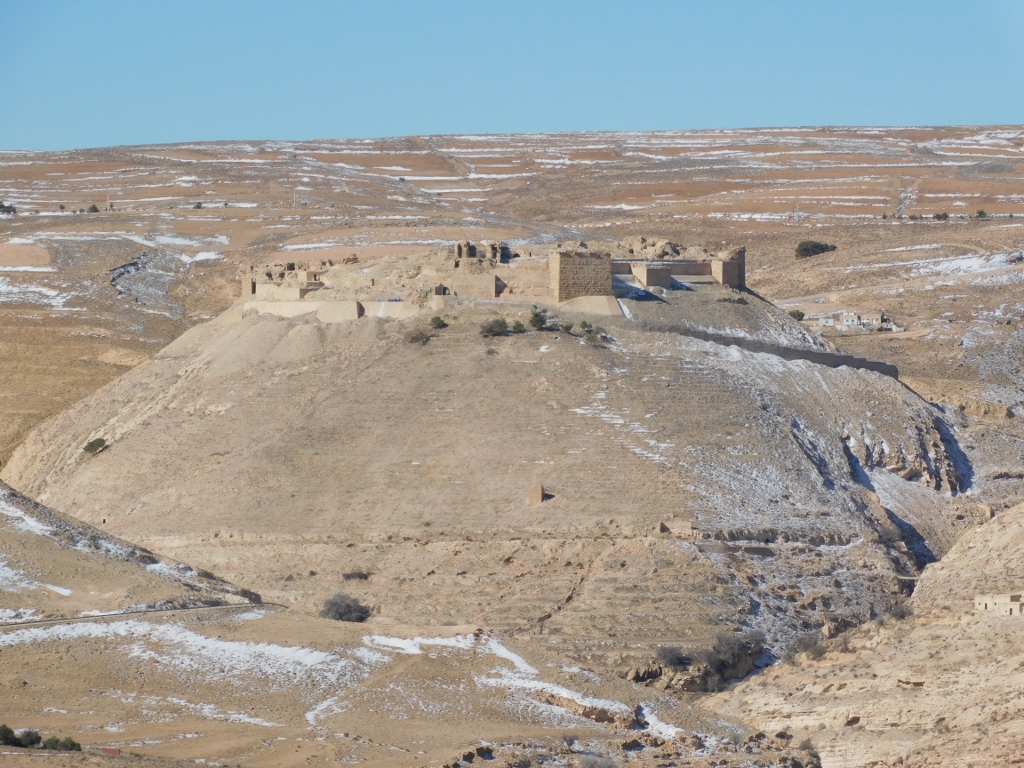 Shobak Castle
Shobak Castle
As I approached the castle, I was fascinated also by its direct surroundings. Namely, it was possible to see clearly both on the hill with the castle, as well as on the neighbouring hills that the rocky ground is such that there are numerous shallow caves, while over time people built stone houses around the entrances into those caves.
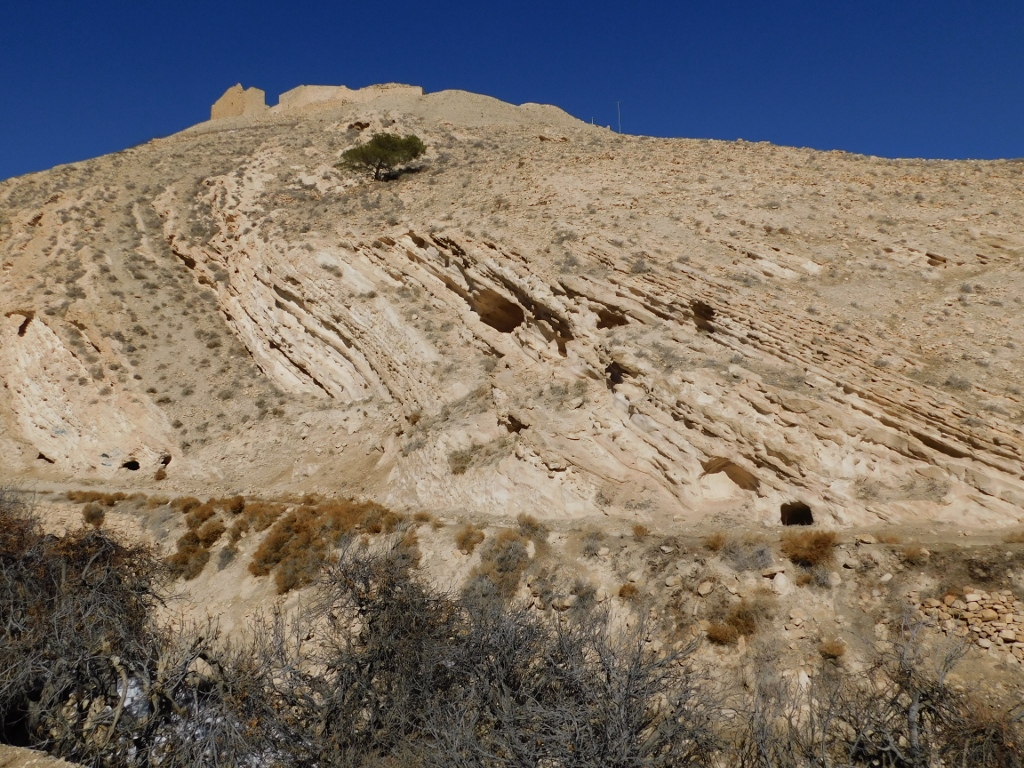 Hill with Shobak Castle on the top
Hill with Shobak Castle on the top
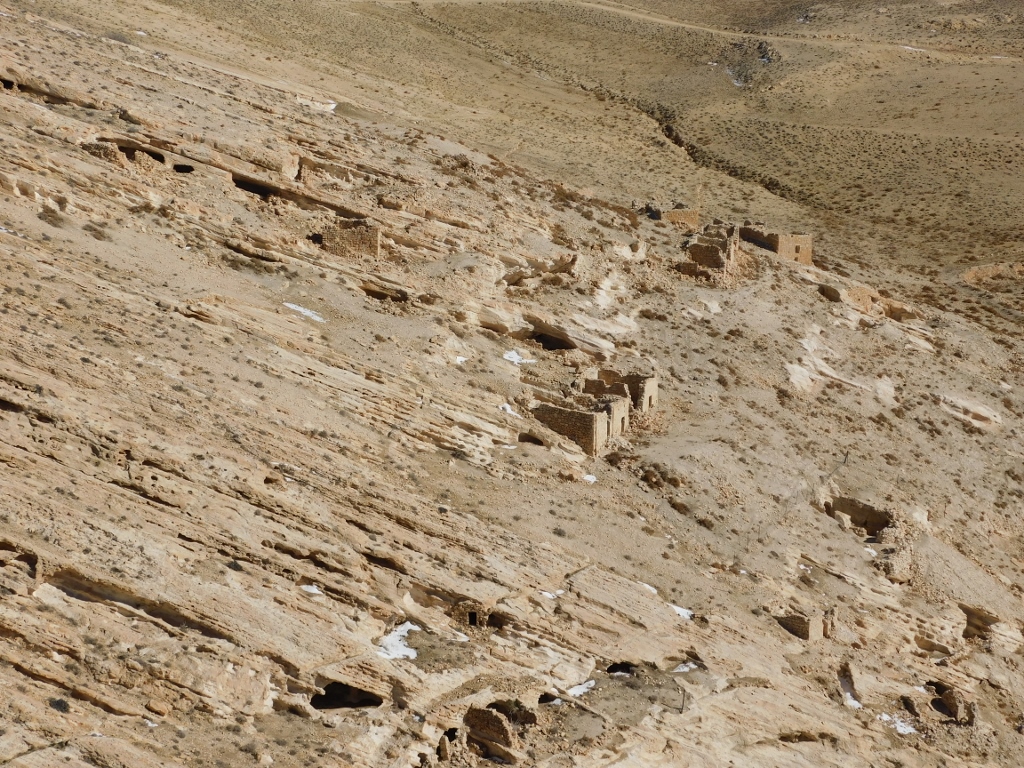 Neighbouring hill east of the castle and the stone houses on its slope
Neighbouring hill east of the castle and the stone houses on its slope
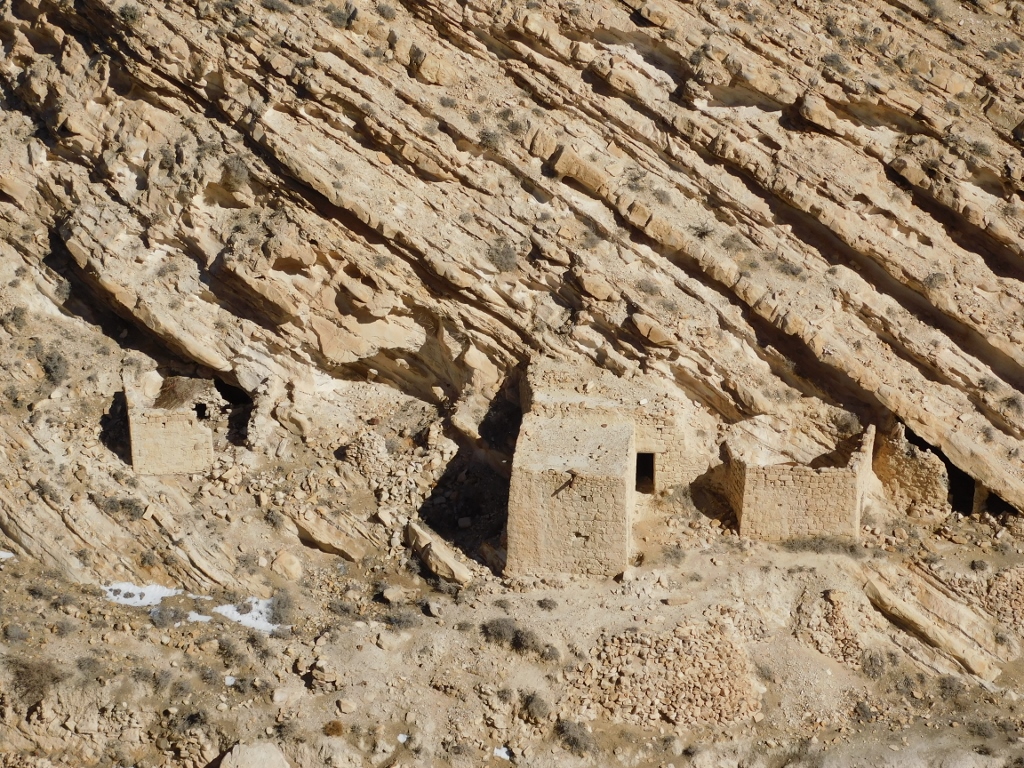 Neighbouring hill east of the castle and the stone houses on its slope
Neighbouring hill east of the castle and the stone houses on its slope
According to what I could find on the internet, these are remains of the old houses built adjacent to these caves using the surrounding material. I don’t know why people don’t write about this more – it seemed utterly impressive to me. On the third hill from which I descended in the car, only to go again up the hill with the castle, it is possible to see a village with often stone houses that are obviously still being used to the fullest, although there are also some old, ruined and abandoned houses. By the way, Shobak village is situated on the other side of the hill seen in the photo below.
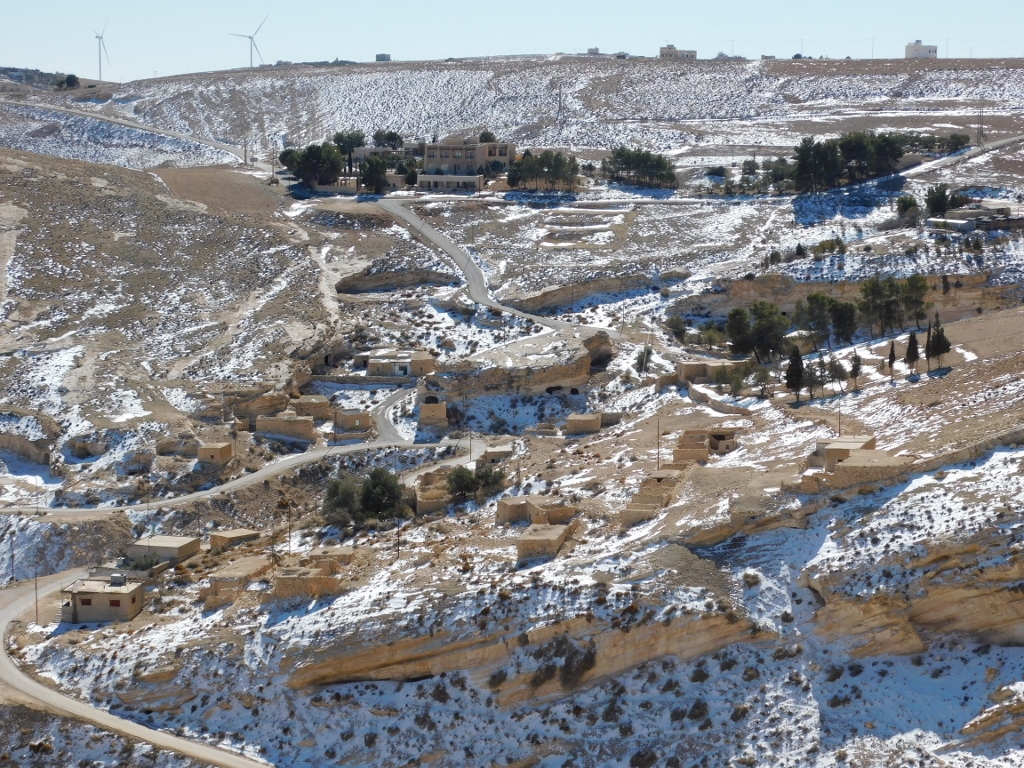 Neighbouring hill, south of the castle (perimeter sections of Shobak village can be seen on the top)
Neighbouring hill, south of the castle (perimeter sections of Shobak village can be seen on the top)
But, let me now concentrate more on Shobak Castle which was the reason why I came here in the first place.
Shobak Castle (or Shaubak, depending on the transcription) also has its other name since the Crusaders who built it called it Montreal and therefore the literature mentions both of these names.
It was built at the altitude of 1330 m a.s.l., on the top of a hill right next to an important crossroad of (trading) routes, which provided it with additional strategic value. This made it possible not only to control those who passed there, but also to tax the merchants, as well as the pilgrims going to Mecca and Medina.
Montreal Castle was built in 1115 by Baldwin I of Jerusalem and because of the contribution of the king himself the castle was given its name – Mont Royal. It is interesting that the first castle here was built in only 18 days and the main goal of the ruler was to settle Franks of all classes here, by which a proper town would be created and not only a military fort. With time, this became a place where both Christian and Muslim populations lived.
At the end of the 12th century, Saladin besieged the castle unsuccessfully, but although the castle was not conquered, it is said that the defenders sold their wives and children in exchange for food. After various military events, the castle eventually moved into the hands of the Ayyubids two years later, in 1189, and apparently, the wives and the children were then returned to the Christian defenders. I don’t know about the children, but I expect that the wives gave them hell.
At the end of the 13th century, the castle was conquered by the Mamluk Sultanate the capital of which was in Cairo (Egypt).
Over time, the castle was certainly added to and reinforced, so today it is possible to see very nice inscriptions in Arabic done in stone and displayed as decoration. But, over time the castle also lost its importance and started to decay. It is interesting that local residents lived in it until the middle of the 20th century and even the function of some of the buildings at the time is known, such as an old village school.
However, today, to an ordinary visitor like myself, this all seems like a large ruin, without any significant signs and inscriptions. So, I just walked around, trying to visit as much as possible within the short period of time that I gave to myself.
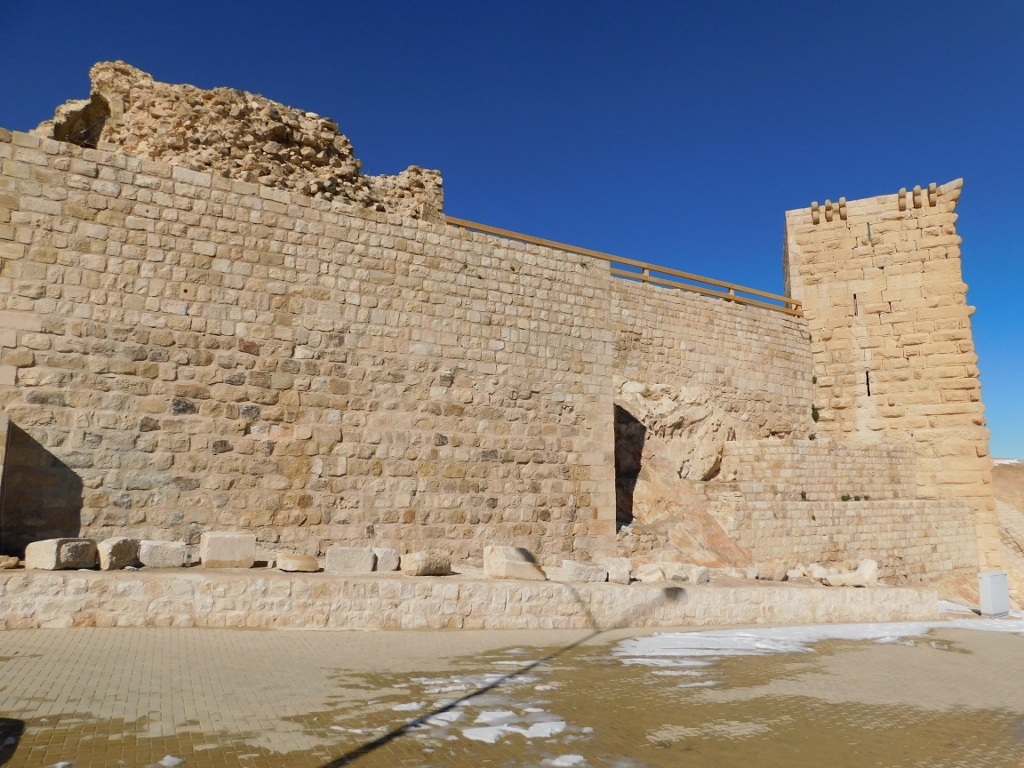 Shobak Castle ramparts beside the access road
Shobak Castle ramparts beside the access road
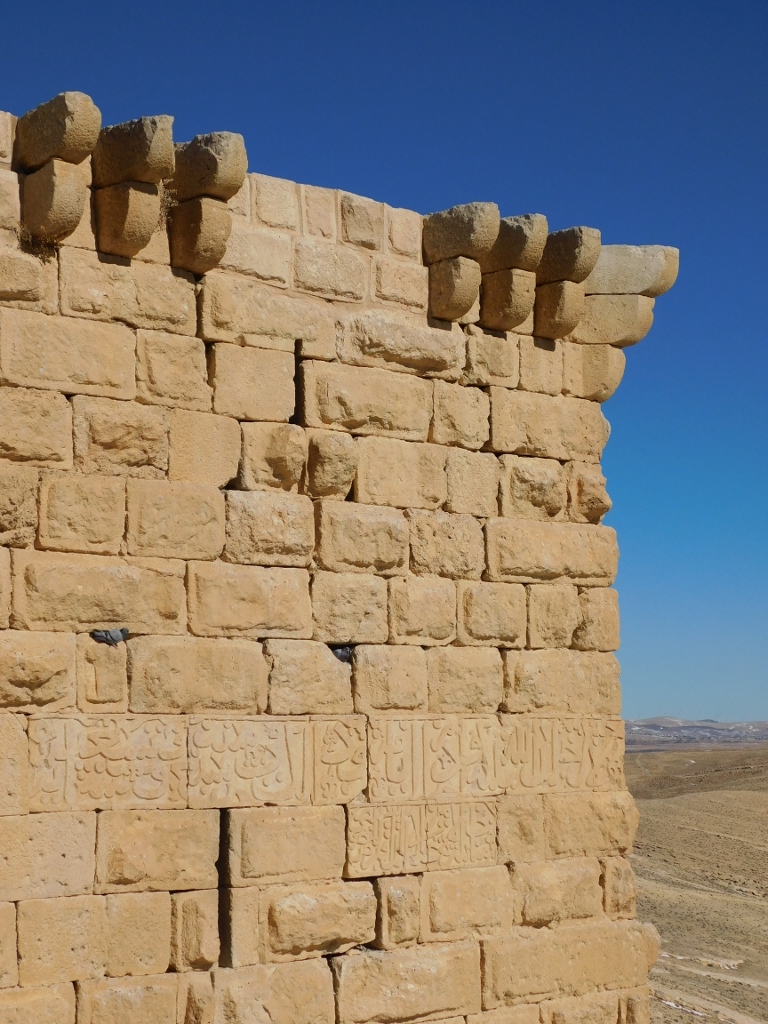 Shobak Castle, a detail with inscription in Arabic
Shobak Castle, a detail with inscription in Arabic
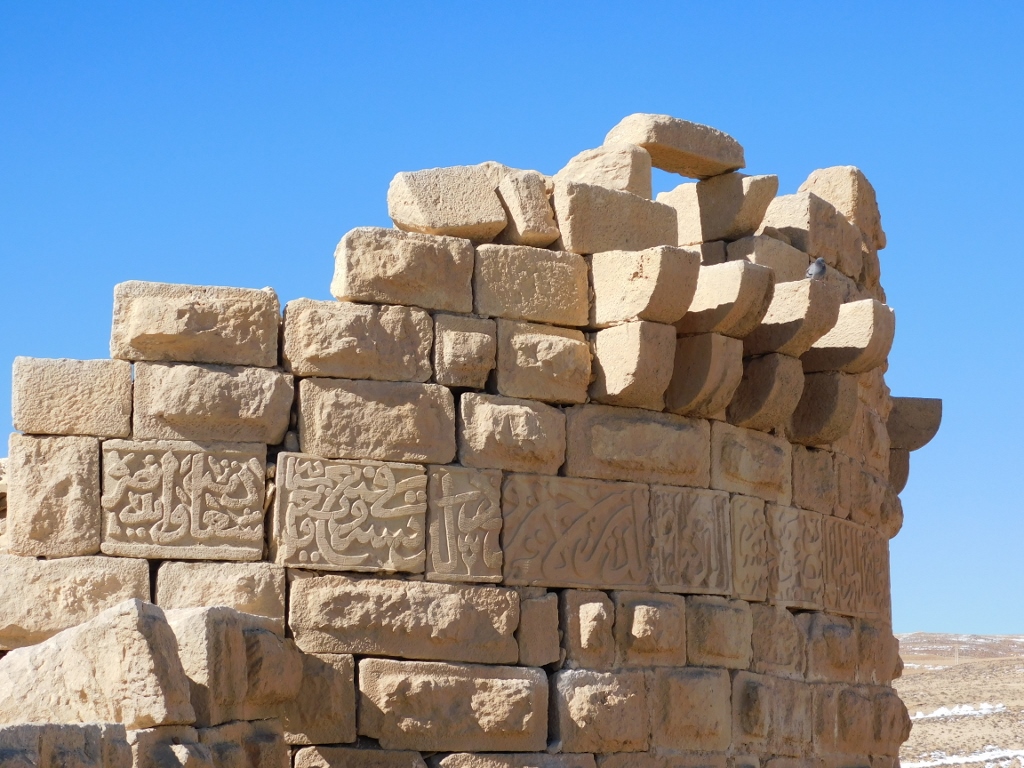 Shobak Castle, a detail with inscription in Arabic
Shobak Castle, a detail with inscription in Arabic
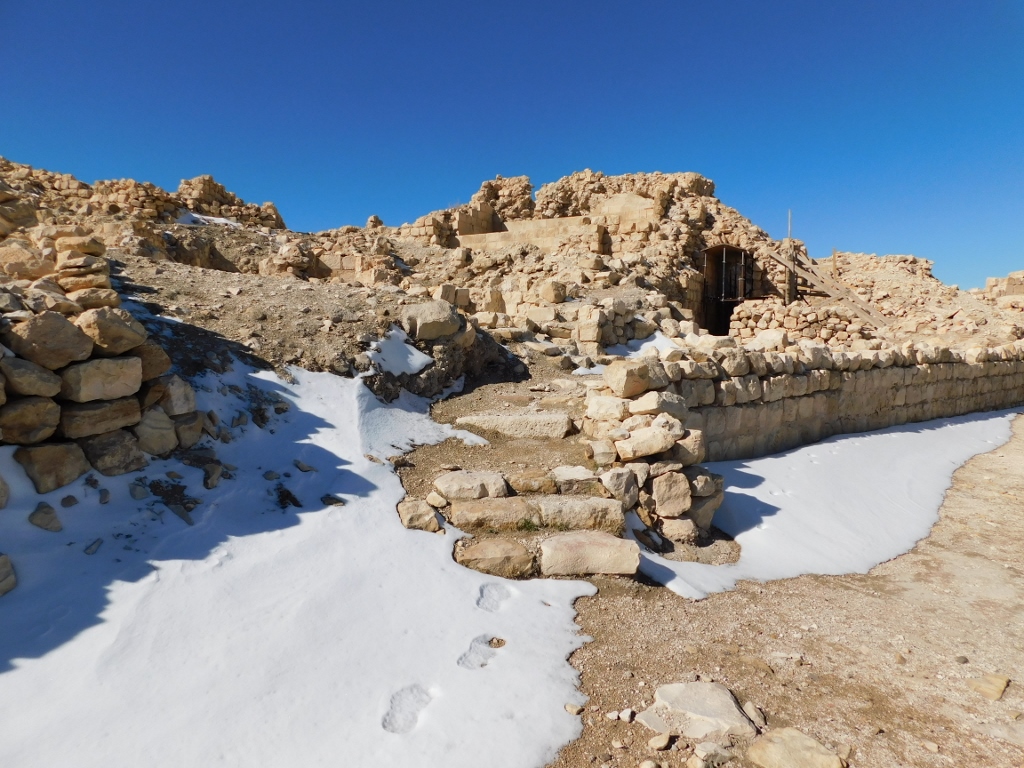 Shobak Castle, a detail
Shobak Castle, a detail
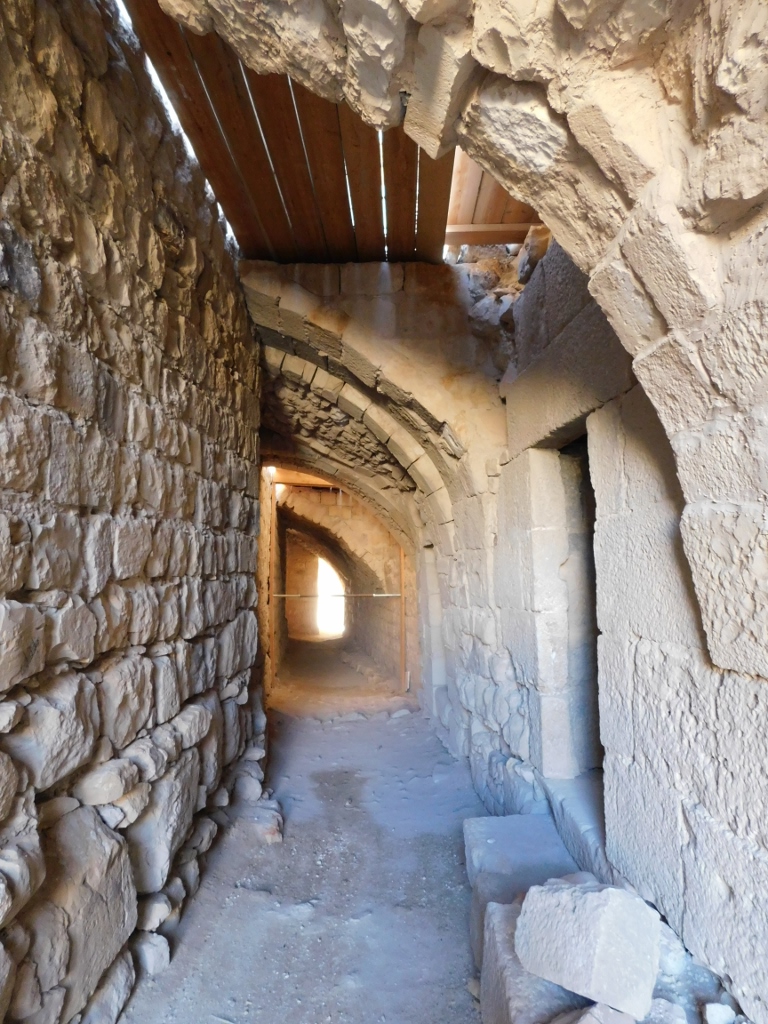 Shobak Castle, a detail
Shobak Castle, a detail
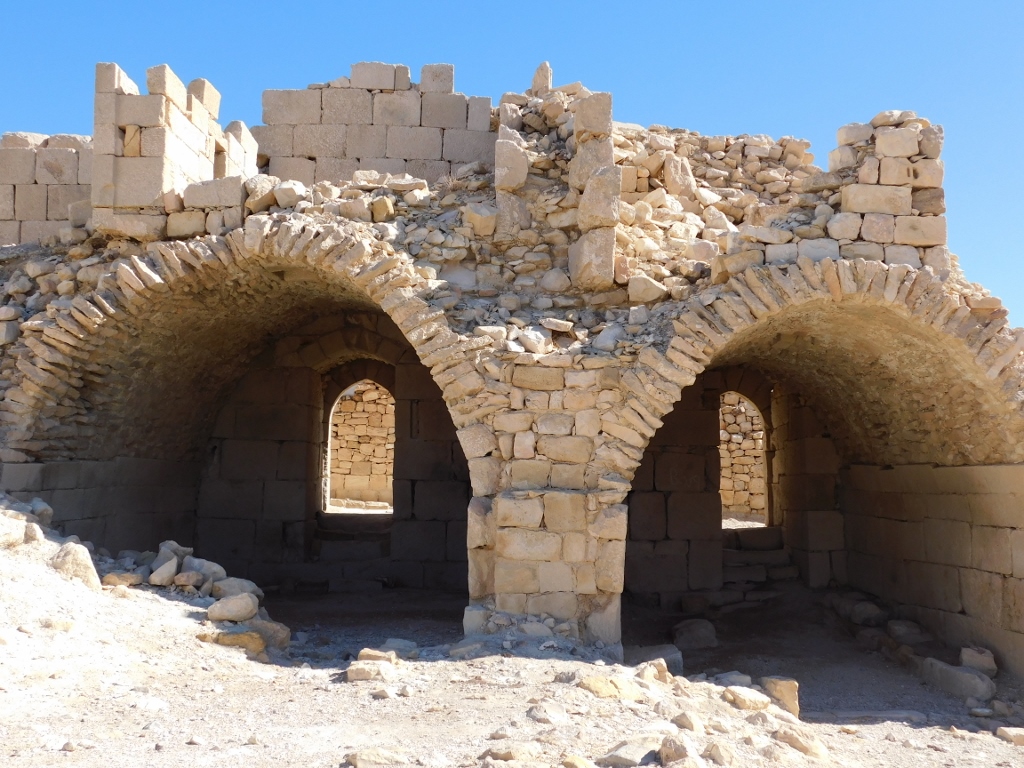 Shobak Castle, a detail
Shobak Castle, a detail
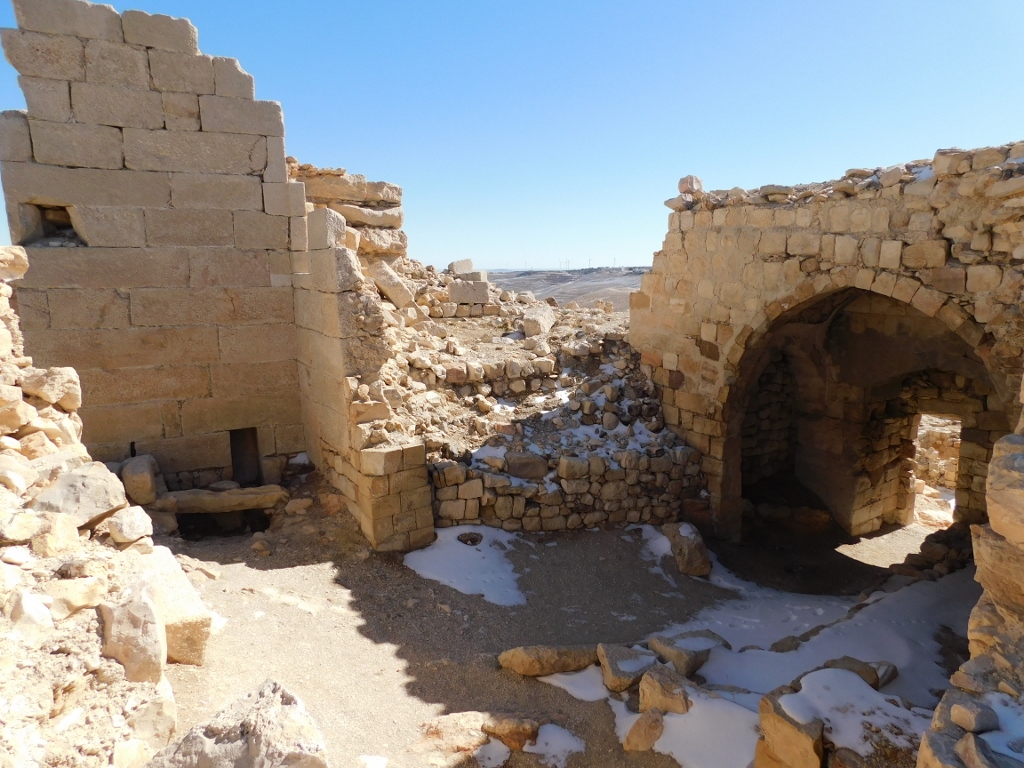 Shobak Castle, a detail
Shobak Castle, a detail
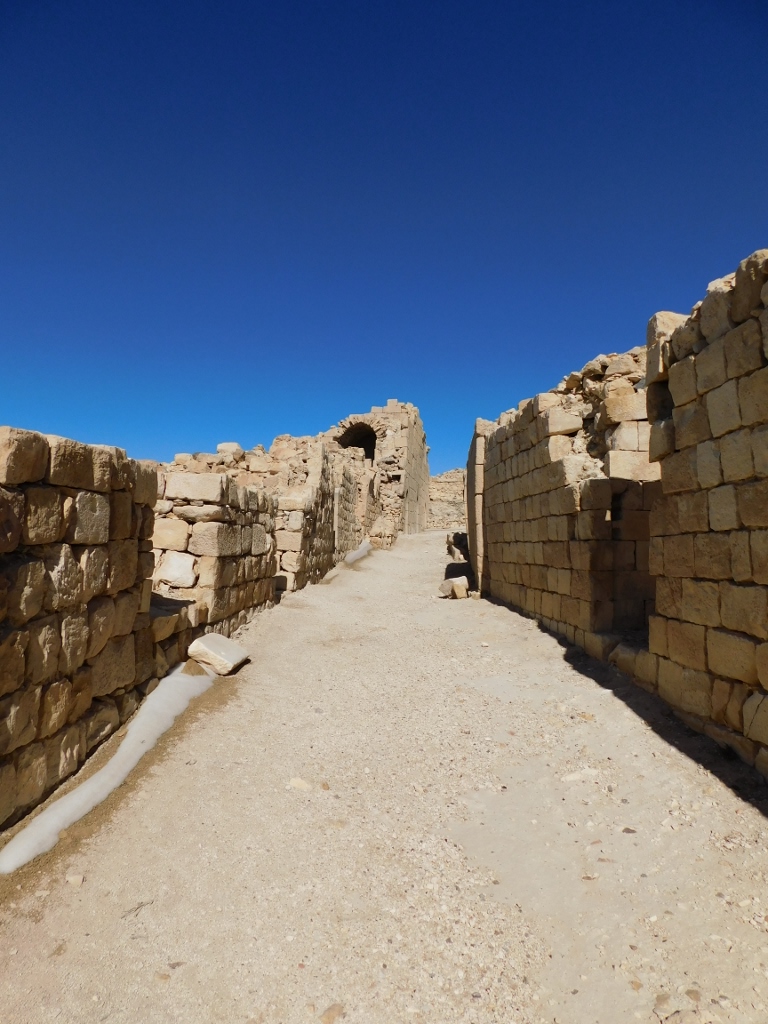 Shobak Castle, a detail
Shobak Castle, a detail
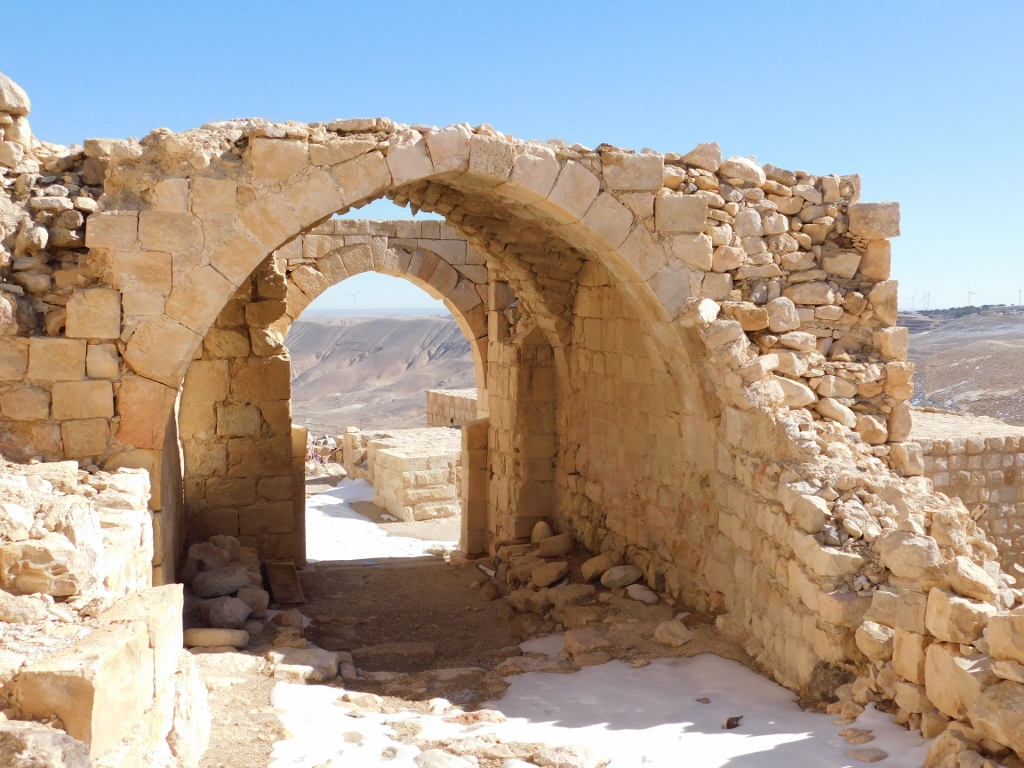 Shobak Castle, a detail
Shobak Castle, a detail
And yet, what continued to fascinate me most here were the surroundings of the hill with the castle that could be seen very nicely from this fine position.
 Landscape to the west and northwest from Shobak Castle (the Visitor Centre is on the right-hand side, on the neighbouring hill)
Landscape to the west and northwest from Shobak Castle (the Visitor Centre is on the right-hand side, on the neighbouring hill)
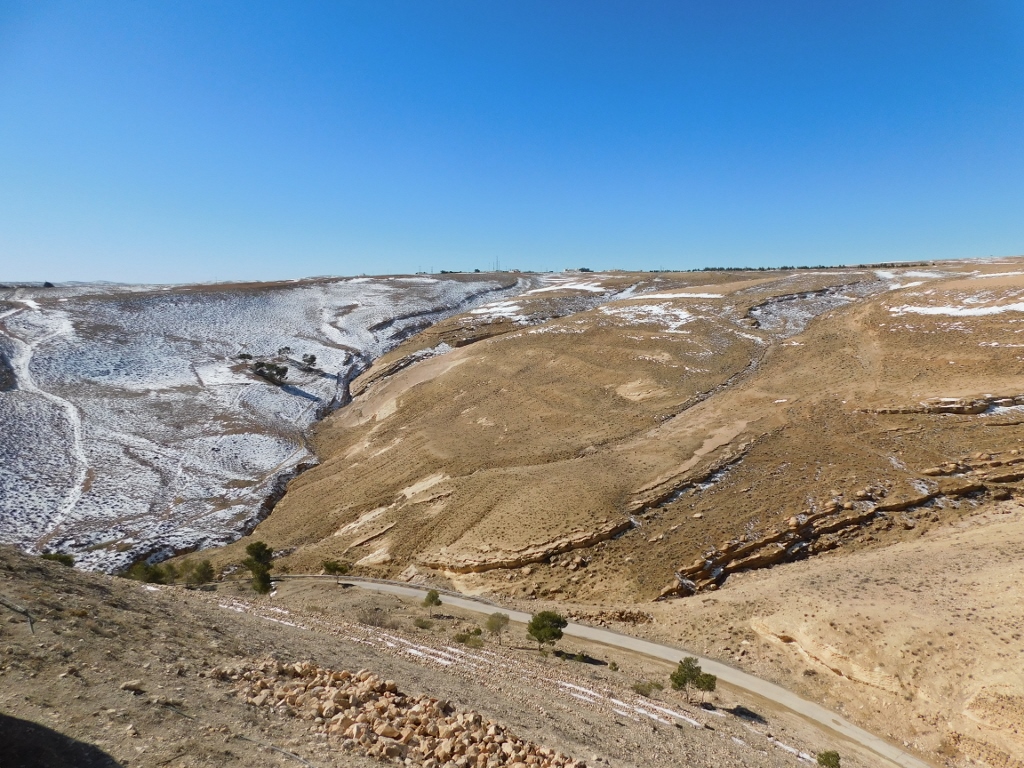 Landscape west of Shobak Castle in January after snowfall
Landscape west of Shobak Castle in January after snowfall
When leaving the castle, I passed again beside the guards from whom I bought the ticket earlier and they were in the middle of enjoying nice warm tea. They invited me to join them, which I did gladly. We chatted a little and then I thanked them and went back to the car by which I continued to the city of Wadi Musa.
As soon as I settled at the hotel in Wadi Musa, I was ready to go and visit Petra. Although I am rather interested in monuments of culture, ruins, old civilisations, etc., generally I’m not prone to spending too much time at such sites. It’s the same in my case when it comes to museums as well. I have already explained this before. And yet, here I had heard from several sources that Petra was large and that visiting it properly could take as many as 3-4 days. Well, that would certainly be too much for me, but I thought it would be good to visit it on this first afternoon, as well as on the following day. Although the entrance ticket to Petra is not an inexpensive thing, the difference between the ticket prices for one day and for two days was negligible.
When I left, the hotel owner showed me which way I should go. It was simple – follow the main street and go down.
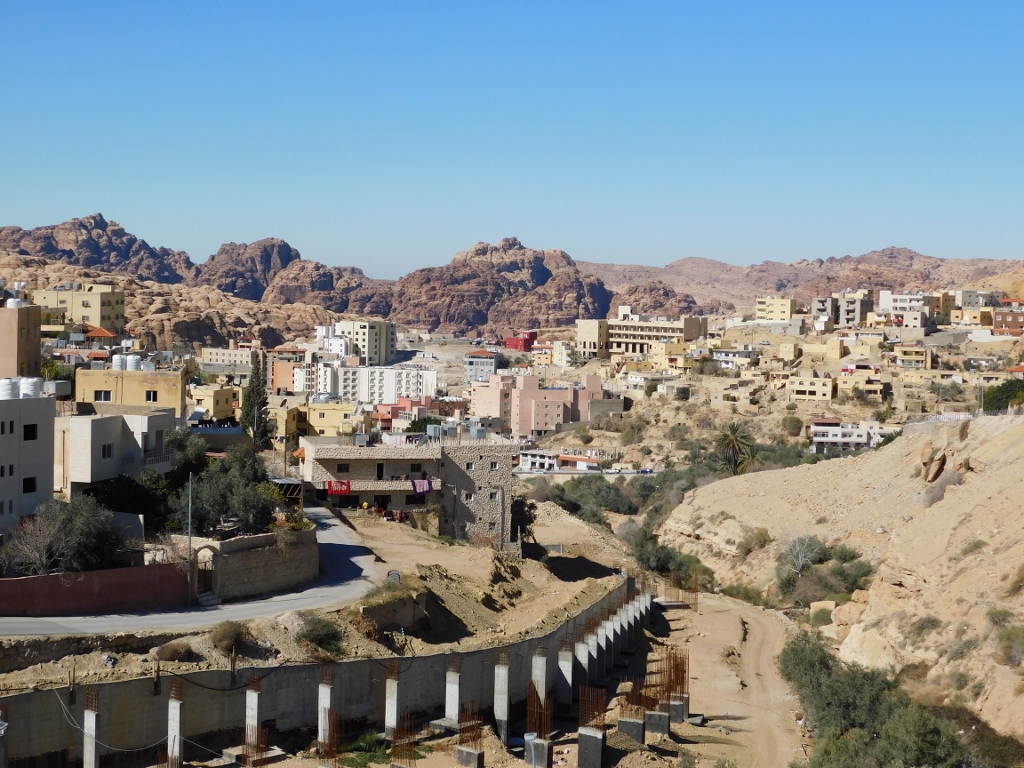 Wadi Musa, view from my hotel room – Petra is among the rocky area behind the contemporary city
Wadi Musa, view from my hotel room – Petra is among the rocky area behind the contemporary city